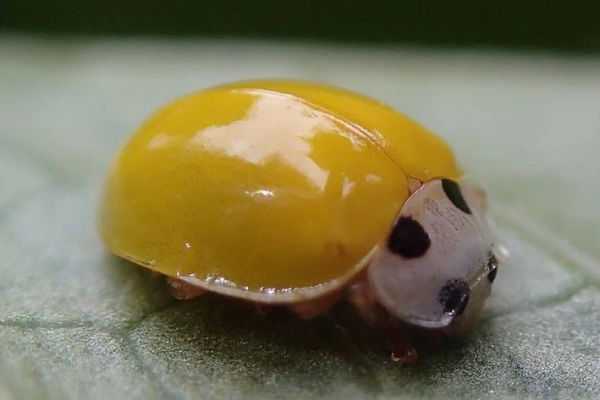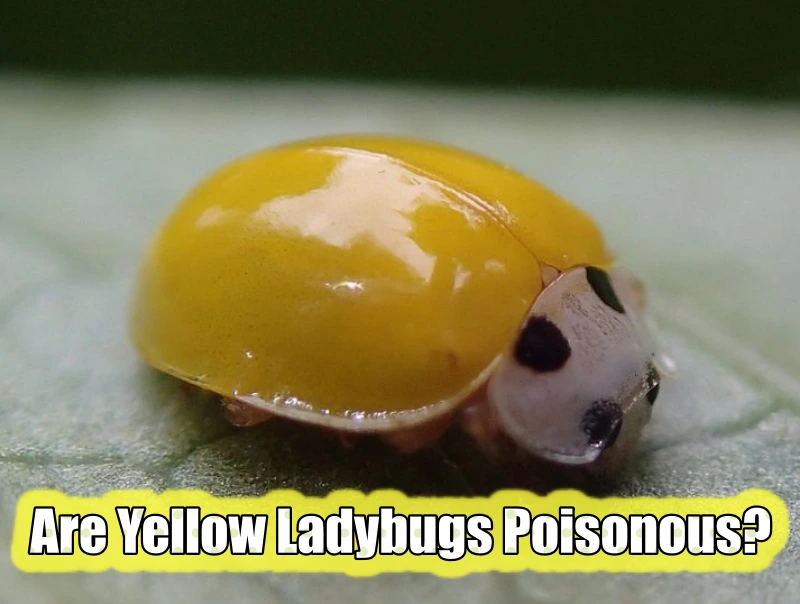Red ladybirds, seen them, heard them, and read about them. But have you ever seen a yellow ladybird? And even if you have, have you ever wondered if, unlike their counterparts, the red ladybirds, they are poisonous?
Well, worry not, because today we are here to clear away any doubts.
Are Yellow Ladybugs Poisonous?
Yellow ladybirds, fortunately, like other species of ladybirds, are not poisonous to humans. They do not pose any harm or contain any toxins that could cause adverse effects on human beings.
However, it is important to note that they might not be the most appetizing thing to consume. As we have read and seen in our previous articles, animals often display a variety of colors to signal their unpalatability to predators.
As a precautionary measure, it is still important to wash one’s hands after touching them.
With all of this out of the way, let’s dive into the world of yellow ladybirds!
Yellow Ladybugs In Nature
1) 14-spotted ladybird beetle

| Scientific Name | Propylea quatuordecimpunctata |
| Identification | Yellow to light orange body with around 14 black spots |
| Location | Europe, North Africa, and Asia |
The Spotted Amber Ladybird exhibits a remarkable diversity of color and pattern variations, with over 100 different forms documented so far.
These variations include a range of body colors from cream to yellow to light orange.
These ladybirds possess 14 almost rectangular black spots on their elytra (wing covers), hence their name.
However, it’s common for several of these spots to fuse into larger markings, often taking the shape of an anchor.
They are entomophagous, primarily feeding on aphids, Aleyrodidae, Coccoidea, and even the larvae and eggs of some other insects.
2) Giant Bamboo Ladybird
| Scientific Name | Synonycha grandis |
| Identification | Long slender legs with yellow body and black spots all over |
| Location | Asia and the United States |
Giant Bamboo Ladybird has bright yellow coloring that sets them apart from many other ladybird species.
Freshly emerged adults exhibit a golden yellow hue with soft forewings.
As they mature, black spots become visible on their forewings, making them stand out even more. They are known to have a great appetite for bamboo aphids.
Giant Bamboo ladybirds emit a foul-smelling yellow-colored fluid as their defense mechanism.
3) Fungus-eating Ladybird
| Scientific Name | Illeis galbula |
| Identification | Black beetle with bright yellow markings |
| Location | Eastern Australia |
Adult Fungus-eating ladybirds are relatively small, measuring about 4-5 mm with a black body adorned with distinct bright yellow markings. The pupa stage is pale yellow and features black tubercles.
Fungus-eating ladybirds are known for their agility and quick movements especially when attacked.
Fungus-eating ladybirds have a beneficial role in gardens, helping farmers and gardeners get rid of pests.
4) Illeis koebelei

| Scientific Name | Illeis koebelei |
| Identification | One of the 5 described species of Illeis. |
| Location | South and East Asia and in Oceania |
Yellow Ladybird Beetle is characterized by its distinctive yellow coloration, most of the time without any markings. These ladybirds are often found in various environments.
Often discovered motionless on the underside of a leaf from a cupid’s shaving brush plant.
Yellow ladybirds are often observed near the corolla of the flowers, suggesting their involvement in pollination.
5) 22-spot ladybird
| Scientific Name | Psyllobora vigintiduopunctata |
| Identification | Yellow color body with 22 black markings |
| Location | Europe |
Measuring about 3–5 mm in length, the 22-spot ladybird is bright yellow.
Along with the yellow coloration they have 22 perfectly round black spots on their elytra, unlike the 14-spot ladybird whose spots often merge into distinct patterns.
They primarily feed on mildew, a type of fungus helping the host plants to get rid of them.
The 22-spot ladybirds are most seen from April to August, during the warmer months when they are active.
6) Lady Beetle
| Scientific Name | Megalocaria dilatata |
| Identification | Orange-yellow body with around 10 black spots |
| Location | India, Sri Lanka, and Bhutan. |
Lady Beetles are relatively large, with a body length of approximately 11 mm.
Their body color varies from bright orange to yellowish with ten black spots on their elytra.
Lady Beetle’s head also has diamond-shaped elongated spots on either side of the inner margin of the eyes.
During their larval stage, they are voracious predators, primarily preying on various aphid species and this behavior of theirs continues even as they turn into an adult.
7) Large leaf-eating ladybird
| Scientific Name | Papuaepilachna guttatopustulata |
| Identification | Black elytra with yellow or yellowish-brown prothorax |
| Location | Australia and New Zealand |
While Large leaf-eating ladybird’s elytra and pronotum are primarily black the lower front part of the elytron is either yellow or yellowish-brown.
Both the larvae and the adult ladybirds feed on the foliage of plants belonging to the Solanaceae family.
Unlike the other species we’ve discussed above, large leaf-eating ladybirds are considered to be pests due to their eating habits.
Conclusion
This brings us to the end of this article. Now we know that yellow ladybirds like the other species are not poisonous to humans and you can always feel free to welcome them in your garden for their vast role in getting rid of pests like aphids. Hope this article helped the readers discover nature and its wonderful works.
Also Read:

Hi everyone, my name is Shawna, and I’ve always been fascinated by the fascinating diversity of flora and fauna that our nature has in it. I am currently studying biotechnology and am particularly interested in animal biotechnology, delving into the intricate processes that define their true nature and uniqueness.
